Highlights
- Cover crop-based organic no-till soybean production was evaluated at 16 locations – 9 observational sites and 7 replicated trial sites – in 2019 and 2020
- Across all replicated trial sites, cover crop-based organic no-till soybeans yielded 22 bu/acre less than those grown with standard practices. Yield reductions are believed to be due to a combination of soil moisture depletion, soybean stand damage at crimping and weed competition.
- Based on yield results to date, cover crop-based organic no-till soybean production is not recommended on a large scale. Interested growers should assess the system on a small acreage. Further research is needed to evaluate performance over more seasons.
In the news: To plant green or to plant brown? Rye cover crop termination timing before soybeans (Field Crop News)
Purpose
The overall objective of this two-year project was to determine methods to manage a cereal rye cover crop to achieve multiple benefits, while minimizing any negative effects on crop yield. The project had two components: 1) to evaluate spring rye termination timing and its effects on nutrient uptake, weed abundance and soybean development and yield, and 2) to evaluate a cover crop-based organic (or herbicide-free) no-till soybean production system using a roller crimper to terminate cereal rye. This report includes information on the second component. For information on the first, refer to “Maximizing cereal rye cover crop management for multiple benefits: Spring termination timing”.
Cover crop-based organic no-till soybean production has been popularized by the Rodale Institute in Pennsylvania. The system uses a roller crimper, a drum with chevron-shaped metal attachments (Figure 1), which crimps the stems of rye (or another suitable plant) once it has reached anthesis and kills it. Soybeans are then typically seeded into the mulch, which, if thick enough, provides season-long weed suppression. The cover crop-based organic no-till system offers advantages in terms of labour savings and soil health improvements.
Research in states with similar climates to Ontario, including Wisconsin and New York, has found that the system can produce comparable yields to wide-row, tillage based organic soybean production. Trials have not been conducted to date in Ontario, however, and on-farm experiences with the system have been mixed. The purpose of this trial was to evaluate cover-crop based organic soybean production, using established best practices, across a range of Ontario soil and climate conditions.
Figure 1. A front-mounted roller crimper being used to terminate cereal rye at anthesis in Ontario, June 2019
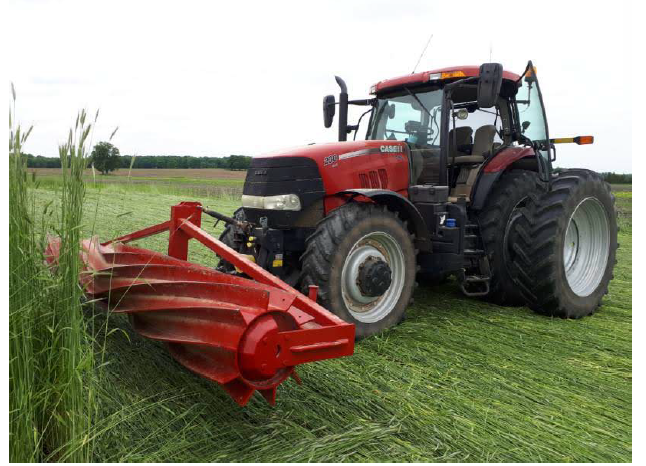
Methods
Replicated and randomized strips were used to compare cover crop-based organic no-till soybean production with standard production practices. Observational, full field sites of cover crop-based organic no-till soybeans were also monitored. Cereal rye and soybean seeding rates, dates and methods can be found in the results section. Cereal rye biomass, soybean population and seeding conditions, soil temperature and moisture and soybean development and yield were measured.
At the replicated, randomized strip trial sites, neither tillage nor herbicides were used to manage weeds in the rye treatments. Either tillage (primary and secondary tillage, tine weeding, inter-row cultivation) or herbicides were used to manage weeds in the no rye control treatment. All sites (except Bornholm in 2020) were a two-treatment comparison: roller crimped vs. a no-rye control. Soybeans were seeded at a high rate in the roller crimped treatment as per best practice for organic no-till. No-rye control strips were generally seeded at the same rate to maintain consistency between treatments.
At Bornholm, additional treatments were included to evaluate the impact of soybean seeding date, soybean seeding rate and cereal rye termination timing. The treatments were:
- No rye (control) – planted May 23 @ 300K seeds/acre
- Early seeded soybeans (into standing rye) – planted May 23 @ 300K seeds/acre, crimped June 13
- No rye (control) – planted June 9 @ 300K seeds/acre
- Early terminated rye – sprayed April 27, planted June 9 @ 300K seeds/acre
- Late seeded soybeans (into standing rye) – planted June 9 @ 300K seeds/acre, crimped June 13
- Late seeded soybeans (into standing rye) – planted June 9 @ 225K seeds/acre, crimped
June 13
Observational sites did not involve different treatments; instead, they were either full or partial fields in which cover crop-based organic no-till soybean production was attempted.
Common rye was seeded on an angle (greater than 20⁰) relative to the direction of crimping at all sites. Background site information can be found in Table 1.
Figure 2. Aerial view of replicated and randomized plot at Drayton site, spring 2019.
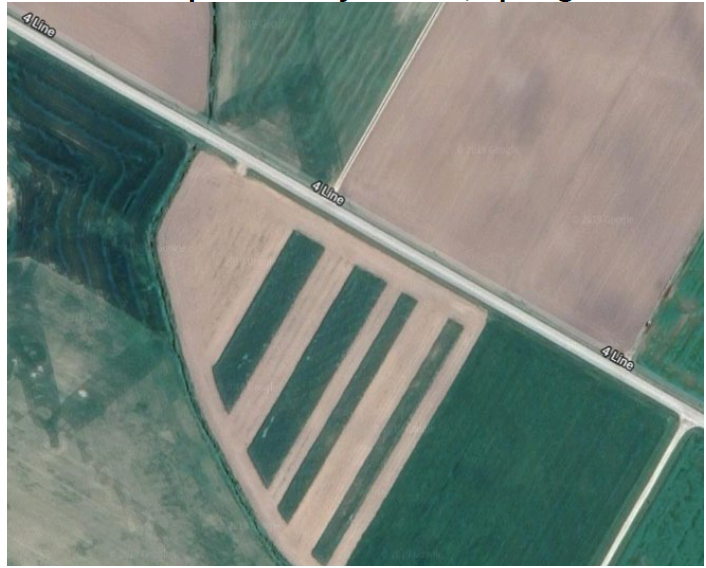
Table 1. Site descriptions.
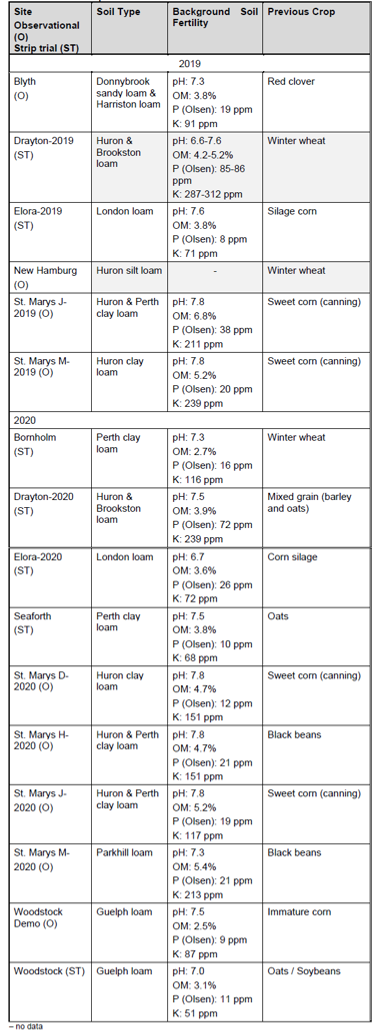
Site measurements and monitoring
All sites were monitored on a regular basis. At strip-trial sites, observations, measurements and samples were collected from multiple locations within each strip. At observational sites, geo-referenced locations (8-10 per field) were established and used throughout the season for data collection. Measurements included cereal rye biomass and carbon-to-nitrogen ratio at time of termination (Table 2), soil nitrate samples, soybean stand (Table 3), height and growth stage (Table 4) and soybean yield (Table 5). Soil temperature and moisture was also measured at the Elora site (2-inch depth) in 2019 and the Bornholm site (2 and 12-inch depths) in 2020 in a minimum of three replicates using sensors and automatic data-loggers (Figure 3).
Figure 3. Soil temperature and moisture sensors installed at the Bornholm site in 2020 (left) and the Elora site, 2019 (right). Readings were logged hourly throughout the growing season.
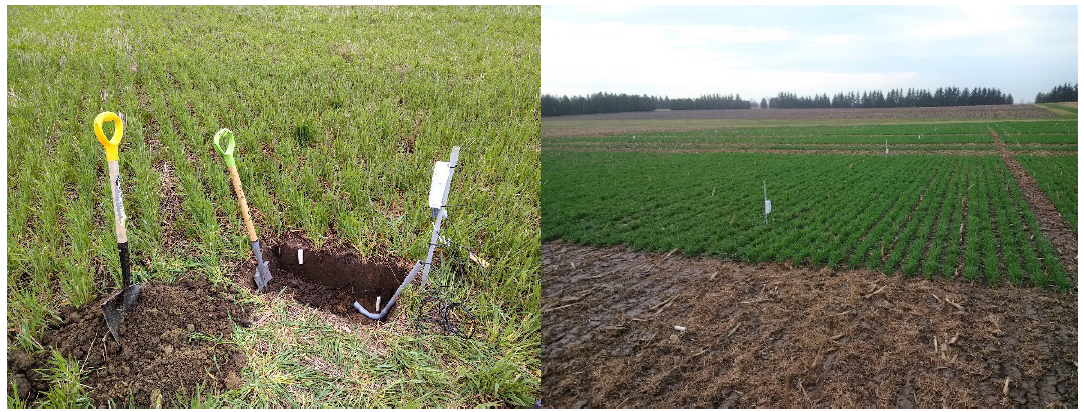
Yield was determined by weigh wagon or by combine scale at strip trial sites plots. Yield self-reported by cooperating farmers at observational sites. Values adjusted to 13% moisture. Statistical analysis was performed on yield data. Different letters indicate a significant difference (P < 0.10).
Methods
Cereal rye biomass
Across all sites, the average biomass achieved at the time of termination was 5,221 lbs/acre of dry matter (Table 2). According to research from regions such as southern Pennsylvania and North Carolina, a minimum of 8,000 lbs/acre biomass is required for sufficient weed suppression. More northern regions, however, such as upper New York state, have found 6,000 lbs/acre to be sufficient. Early spring growth is also critical for competition with weeds. The Drayton 2019 and 2020 sites had excellent early season canopy coverage (Figure 4a) and reasonable biomass, which contributed to strong weed control both seasons. Other sites, including Elora-2020, produced insufficient rye biomass to compete with and suppress weeds for the season (Figure 4b).
Figure 4. Thick cereal rye stand at Drayton-2020 site on April 30, 2019 (left) compared to a thin stand at the later-seeded Elora-2020 plot on May 1, 2020 (right)
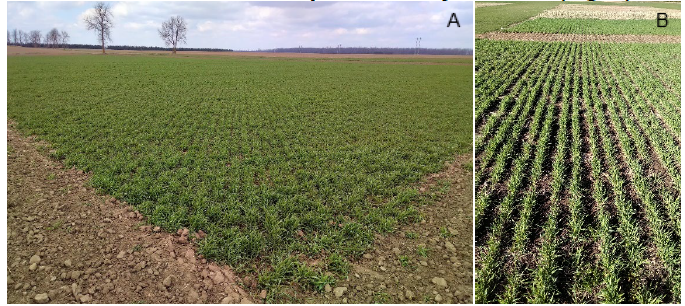
Date of rye seeding was strongly correlated with biomass (Figure 5). Earlier seeded rye generally had a higher tiller count and higher biomass. Based on 16-site years, it appears that seeding before September 22nd was critical for achieving greater than 5,500 lbs/acre dry; sites seeded after that date generally had low biomass.
Figure 5. Cereal rye biomass at time of crimping
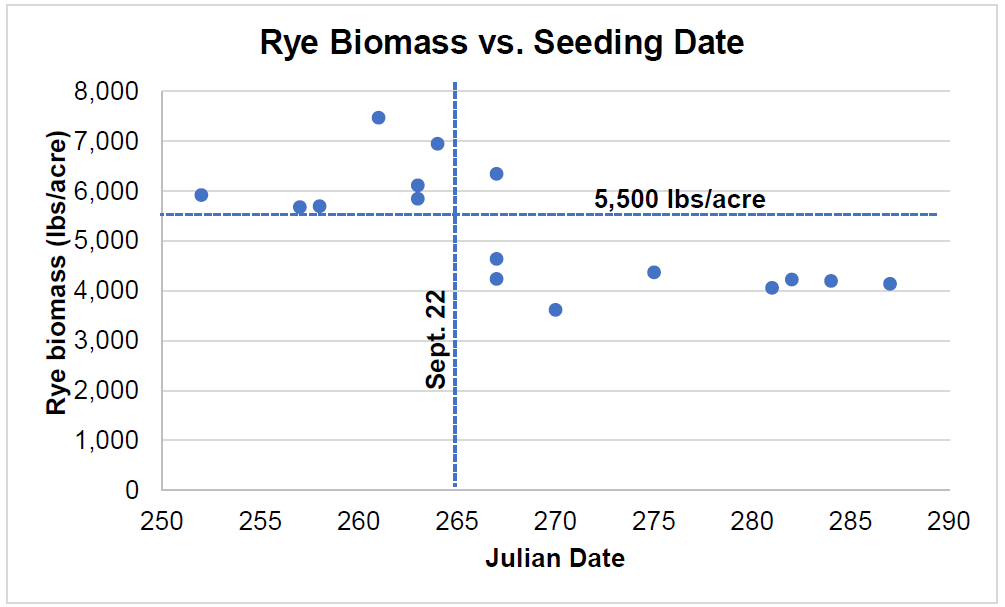
Date of rye crimping varied by site and did not reflect exact timing of rye anthesis, though it gives a reasonable indication. Crimping occurred slightly earlier at sites in 2020 vs. 2019, in part due to warmer and drier conditions. On average across all sites both years, crimping occurred on June 10th (Table 2). The earliest date of full anthesis and crimping occurred at the Woodstock sites in 2020 on June 5th. This is a concern, as it is past the optimal soybean seeding date. Late May or very early June is the typical timing of anthesis in nearby US states.
It was not possible to determine the impact of rye seeding rate on biomass in this trial. In 2019, both rates resulted in very similar values (5,400 lbs/ac biomass for 168 lbs/ac rate and 5,000 for 100 lbs/ac rate). In 2020, sites seeded at 100 lbs/acre had very low biomass, but they were also all planted in October. When seeding rye later, rates should be increased to compensate for reduced tillering.
Carbon-to-nitrogen ratio of crimped rye varied from 28.2 to 73.3, with an average value of 49.8.
Table 2. Rye crimping date, biomass, carbon-to-nitrogen ratio and rye seeding date and rate across all six sites.
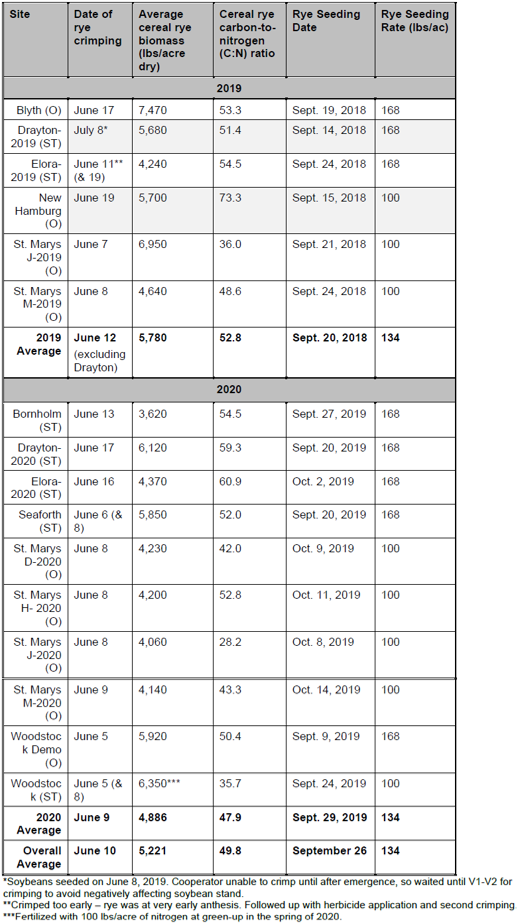
Soil nitrate levels
Soil nitrate samples (0-12 inches) were collected just after crimping across seven strip-trial sites over the two years. The average soil nitrate level under roller crimped rye was 2.5-times less than under the no-rye control (Figure 6). The largest difference was observed at the Drayton-2020 site, where soil nitrate levels averaged 16.8 ppm under no rye and only 4.1 ppm under the roller crimped treatments.
The uptake of nitrogen by rye contributes to its weed suppression, particularly against weeds that thrive under high fertility conditions. The decrease in available nitrogen under the organic no-till system may also help explain the slow early-season soybean growth that was observed (see Soybean growth and development section).
Figure 6. Box and whisker plots showing the median nitrate concentrations (0-12 inches) from 7 strip-trials in 2019 and 2020.
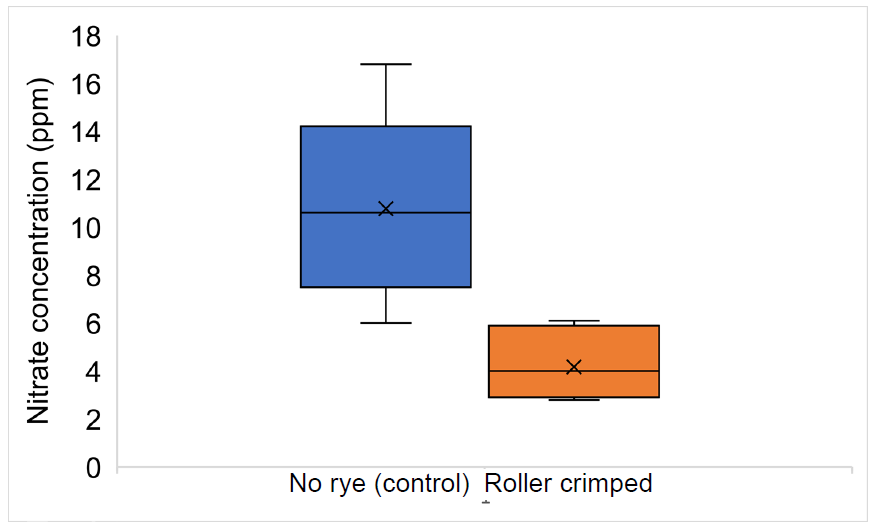
Soybean stands
Seeding soybeans to a sufficient depth, closing the seed slot and achieving an acceptable stand is critical to the success of the system. It is recommended to seed soybeans at a higher rate than normal, anywhere from 225,000-300,000 seeds/acre in organic systems. All strip-trial sites were seeded at 300,000 seeds/acre (or 270,000 for Drayton) in 2020. Farmer cooperators at the St. Marys sites opted for much higher seeding rates both years, in part to compensate for thin rye stands, which resulted in thicker soybeans stands on average. Across strip-trial sites in 2020, the average plant stand for the no rye control was 24% higher (239,000) than the roller crimper treatment (193,000) (Table 3). Both stands were adequate to capture full yield potential.
No-till drills and planters, equipped for high-residue conditions, were used to seed soybeans. Generally, it is recommended to use a modified planter with sufficient down-pressure, sharp cutting coulters or openers and appropriate closing wheels. The drilled fields, on average, achieved acceptable stands both years; slot closure, however, was not achieved by any drill across five sites in 2019 due to moist conditions under the rye at seeding. Fortunately, ample rainfall after seeding across all sites ensured adequate germination and emergence. Dawn Gaugetine closing wheels were used with good success in 2020 on the planter used at Elora, Bornholm and Woodstock sites to address this concern (Figure 7).
Figure 7. Dawn Gaugetine closing wheels used for seeding soybeans into rye mulch at project sites in 2020.
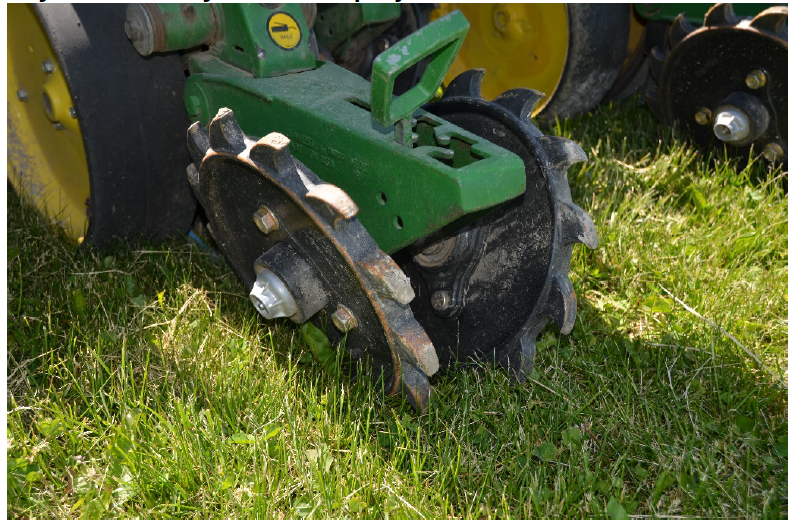
Table 3. Soybean population, seeding rate, method, variety and planting date.
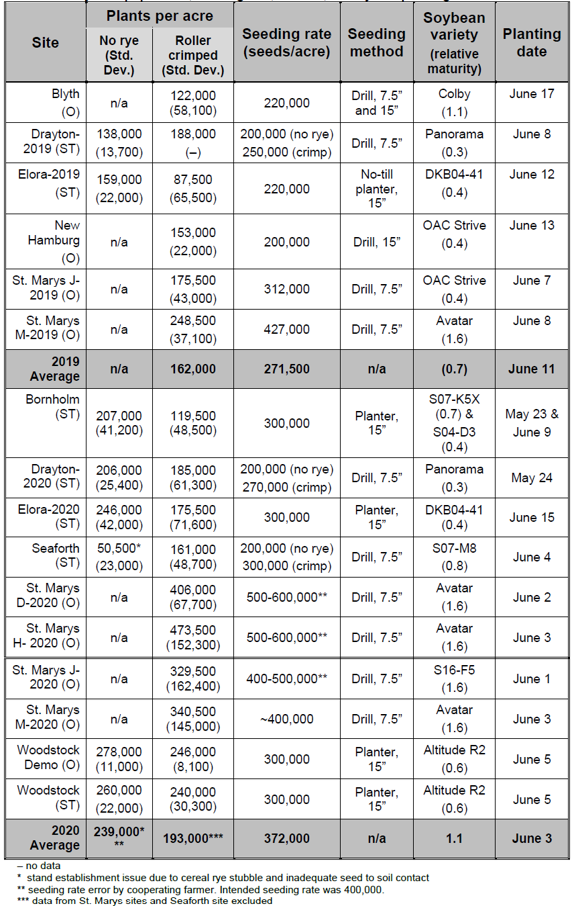
Seeding and stand issues were most pronounced at the Blyth and Elora sites in 2019 and the Bornholm and Elora sites in 2020. At the Elora-2019 (Figure 8) and 2020 sites, as well as Bornholm, crimping after planting causes issues in emergence under tractor tire tracks. Seeds germinated but were not able to emerge underneath compacted surface soil. At the Blyth site, the drill’s inability to cut through thick rye residue (Figure 8) resulted in stand gaps. In situations where high rye biomass is achieved, sharp, well-maintained equipment is critical.
Figure 8. An example of where the no-till drill was unable to cut through rye residue and place the seed into the soil at the Blyth site (left). On the right, a compromised soybean stand in a roller crimped strip at Elora in 2019.
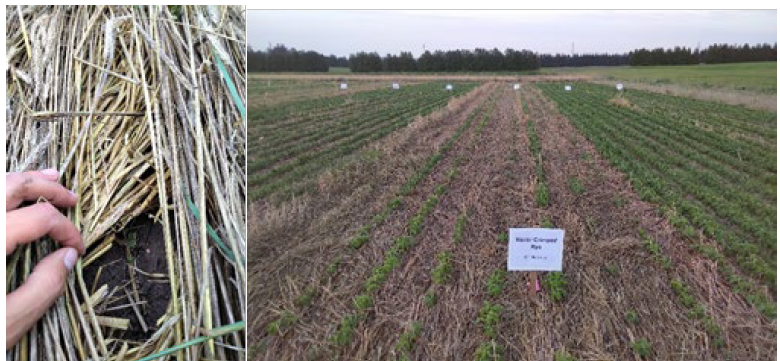
Soybean growth and development
At strip-trial sites, soybeans planted into roller crimped rye lagged one growth stage behind the no-rye control on average and were also much shorter (Table 4 shows Drayton and Elora 2019 sites as examples). Early season growth of soybeans in the rye mulch was very slow, as seen in Figure 9. At most sites, soybeans in crimped rye remained one-third to one-half shorter than no-rye soybeans right up until harvest. An exception was the Elora-2019 site, at which soybeans in rye almost caught up by late August (Table 4).
Table 4. Average soybean height and growth stage at various points throughout the season at the Drayton and Elora sites in 2019.
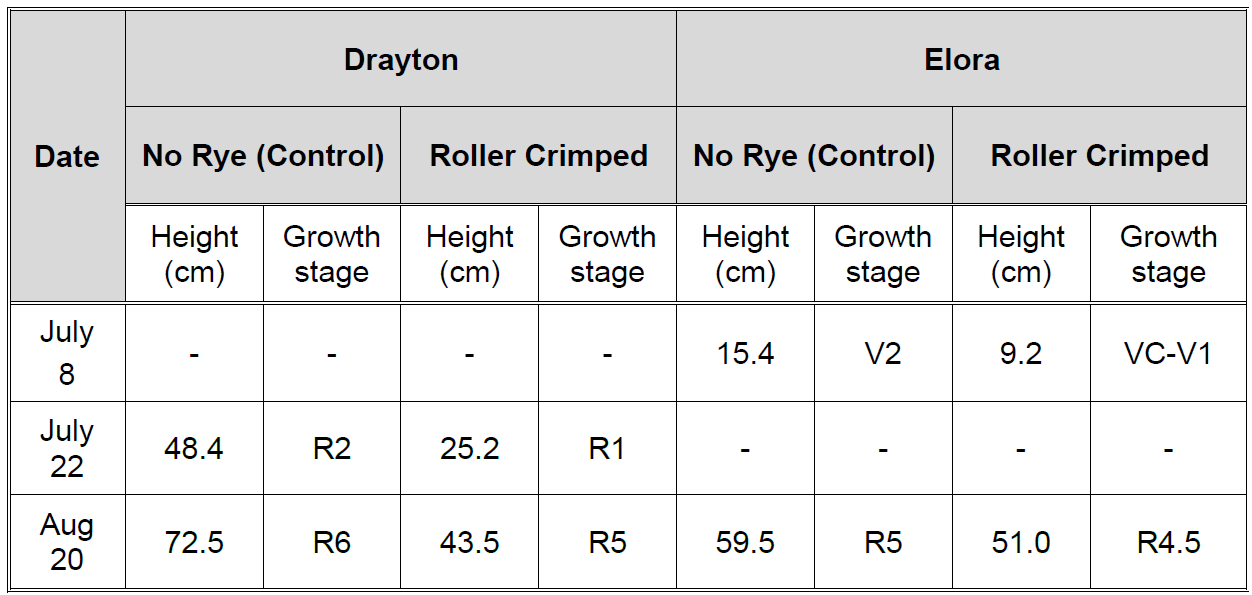
Figure 9. Soybeans in a roller crimped treatment at the Seaforth site in 2020 on July 6th, approximately one month after planting.
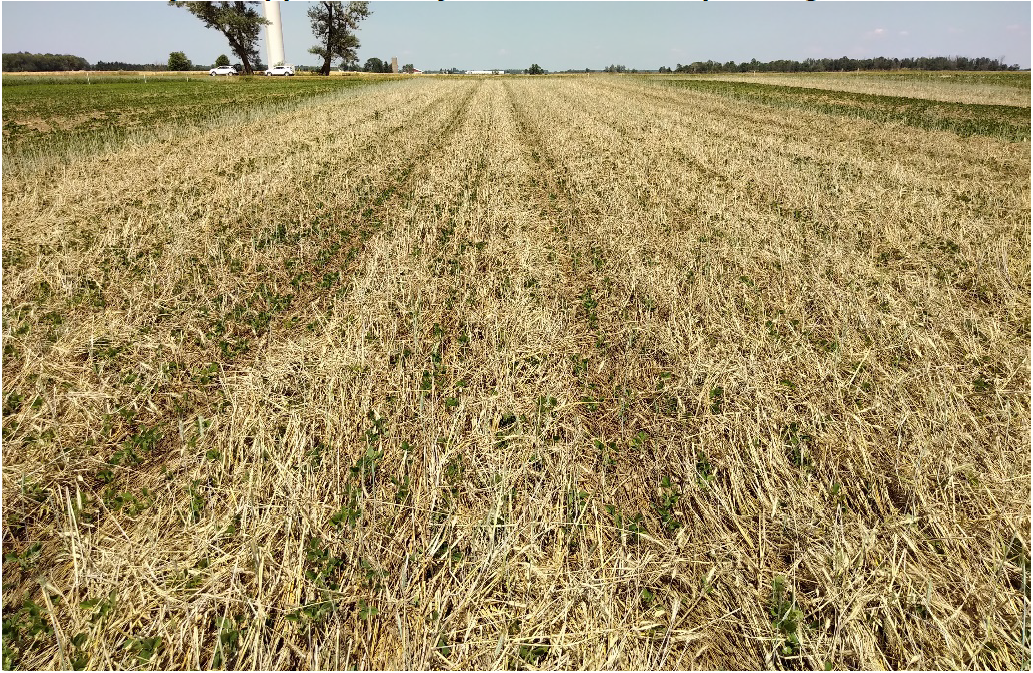
Weed effects
Weed density counts were made at two sites in the 2020 season in June. At the Drayton-2020 site, the presence of crimped rye drastically reduced the density of the predominant species, namely pigweed and lamb’s-quarters (Figure 10). Mechanical weed control by tillage effectively managed weeds on the no-rye control, while weed suppression by the rye mulch also proved effective throughout the season. By harvest, the crimped rye strips had some patches of Canada thistle coming through, but were quite a bit cleaner than the no rye control (Figure 11).
Figure 10. Weed density, expressed as plants per square metre, at the Drayton-2020 site for five prominent weed species. Measured at the V1 stage for soybeans (June 12, 2020).
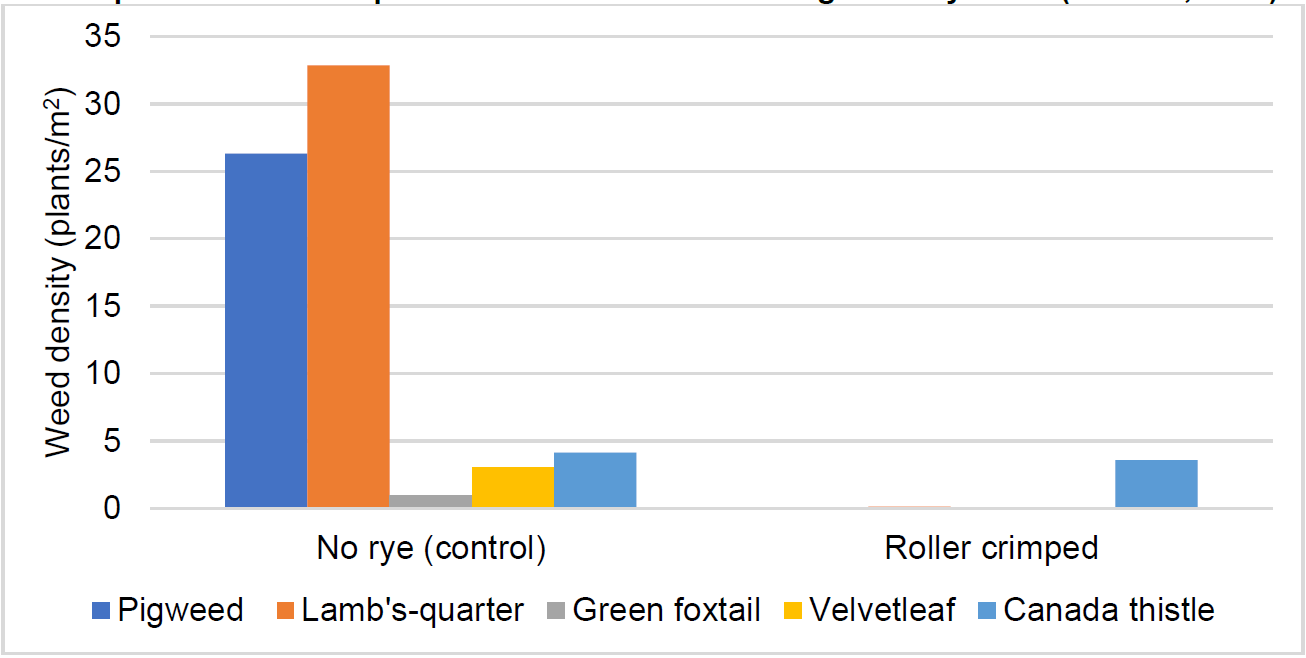
Figure 11. Presence of weeds by season’s end at the Drayton-2020 site. Fewer weeds in the organic no-till rye strips (right) made for easier combining than in the no-rye control strips (left).
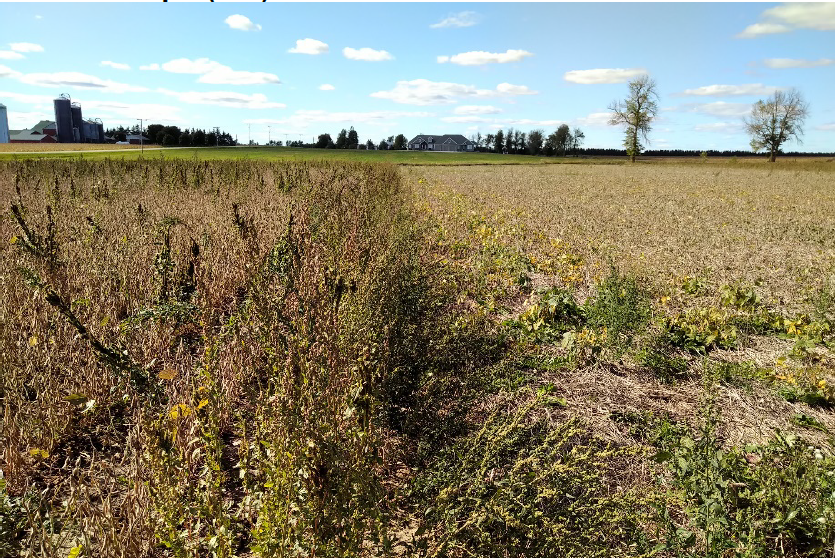
While the rye also greatly reduced weed pressure at the Elora-2020 site, it did not do so to the same degree. With a much higher weed density, the rye strips still had 50 witchgrass plants/m2 (Figure 12). Because the mulch was not thick enough to prevent light from reaching the soil, witchgrass outcompeted the soybeans as the season progressed without supplementary weed control (Figure 13).
Figure 12. Weed density, expressed as plants per square metre, at the Elora-2020 site for four prominent weed species. Measured at the unifoliate stage for soybeans.
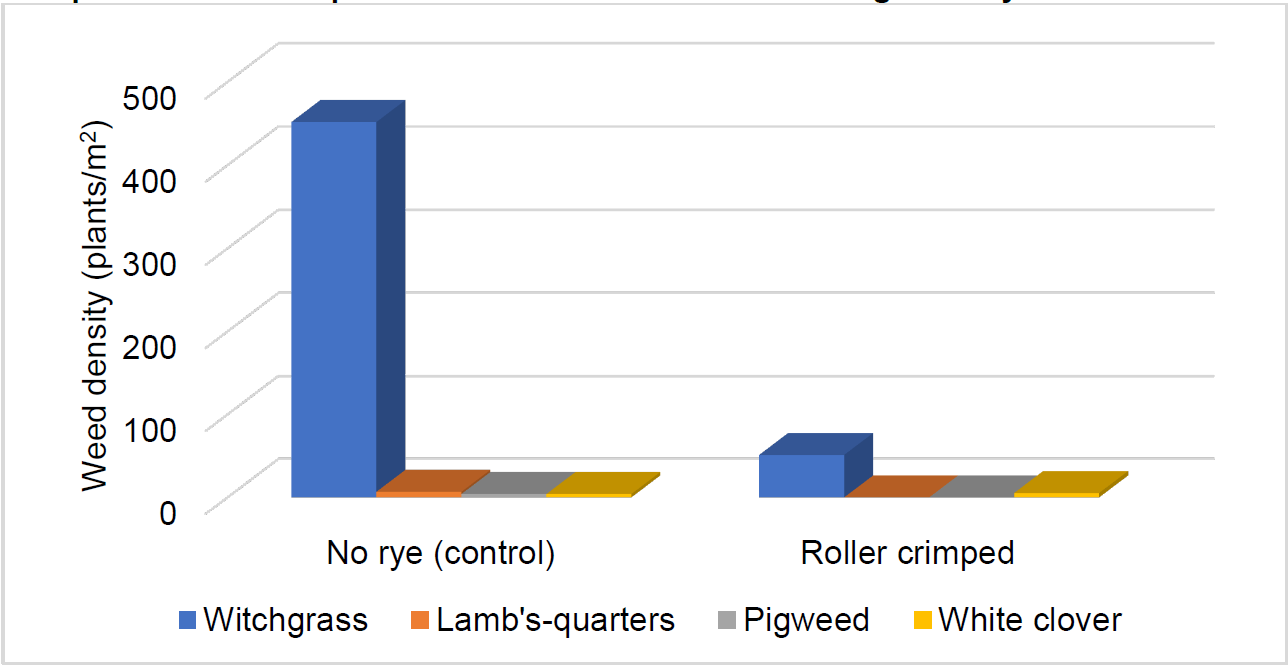
Figure 13. A comparison of a no-rye control vs. a roller crimped treatment at the Elora-2020 site on July 15th (left). The photo on the right shows the roller crimped treatment on September 3rd.
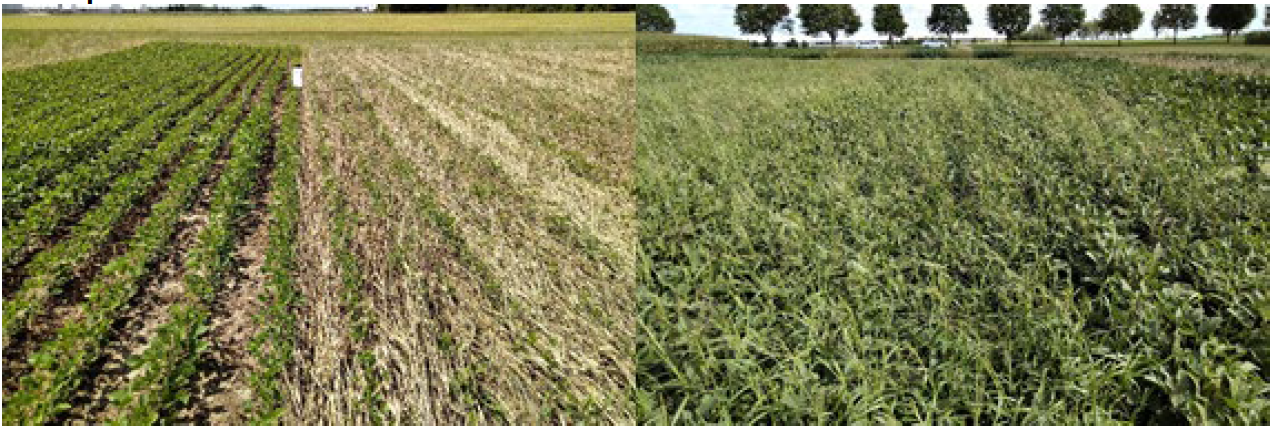
Soil moisture and temperature
Spring
Soil moisture was measured at 2-inch depth, mid-row, in each of the treatments at the Elora-2019 site from late April until harvest. Figure 14 shows the difference in soil moisture from May 7th to June 11th. During this period, soil in the rye treatment was wetter than the no-rye control. The greatest difference in moisture occurred in early May and the gap lessened toward early June. By the date of crimping, soil moisture was only slightly higher in the crimped rye treatment.
The difference in soil moisture was likely due to reduced evaporation from the soil underneath the rye during the wet spring of 2019. As the rye grew rapidly and headed out, however, it began transpiring much larger amounts of water, which would have helped dry out the soil.
Figure 14. Average soil moisture at the Elora-2019 site. Moisture at 2-inch depth in no-rye control treatment (blue) and roller crimped treatment (grey) from May 7 to June 11.
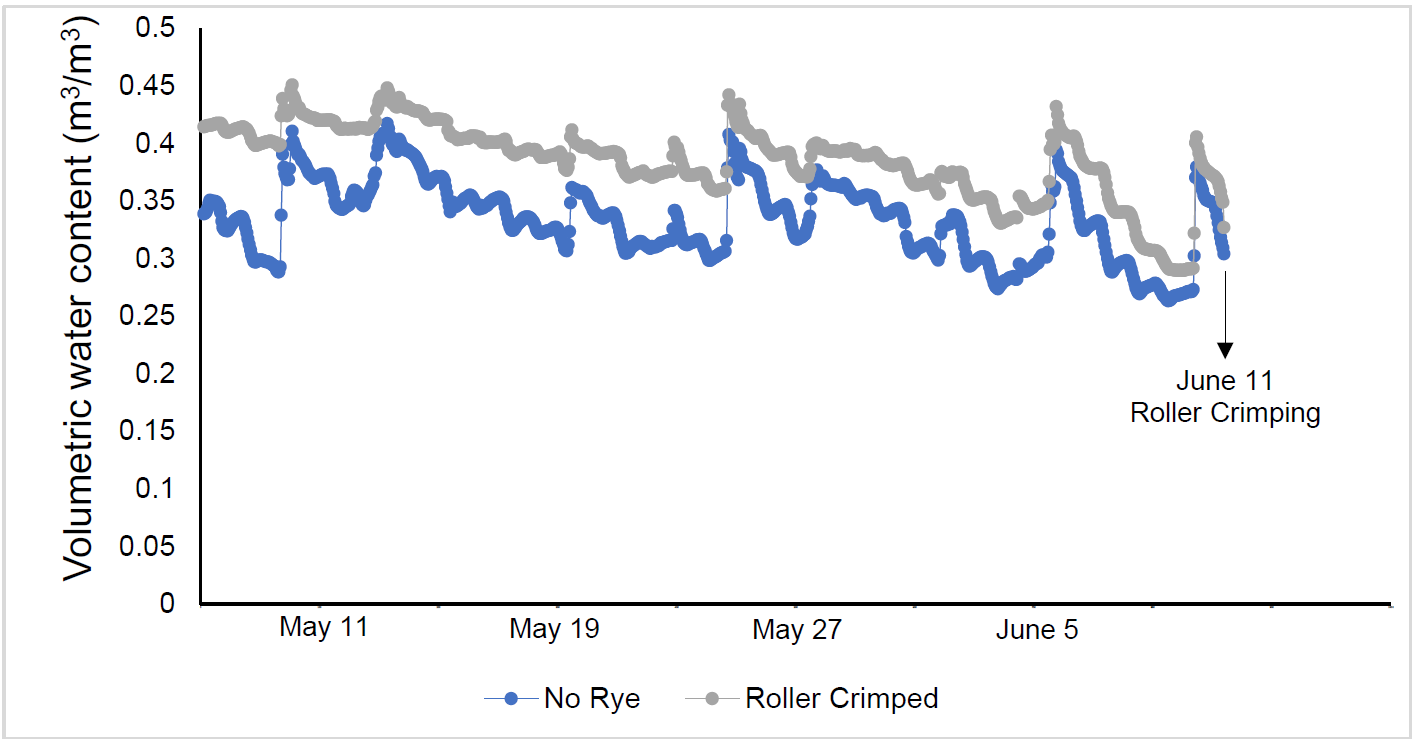
At the Bornholm site in 2020, the opposite effect was observed. Soil under rye was consistently drier from the period of May 23 until planting on June 9th. Even following over 1-inch of rainfall on June 10th, soil moisture was lower in the rye treatment throughout the month of June. This highlights the risk of soil moisture depletion from cereal rye in a drier-than-normal spring.
Figure 15. Average soil moisture at the Bornholm site in 2020. Moisture at 2-inch depth in no-rye control treatment (blue) and roller crimped treatment (grey) from May 23 to June 23.
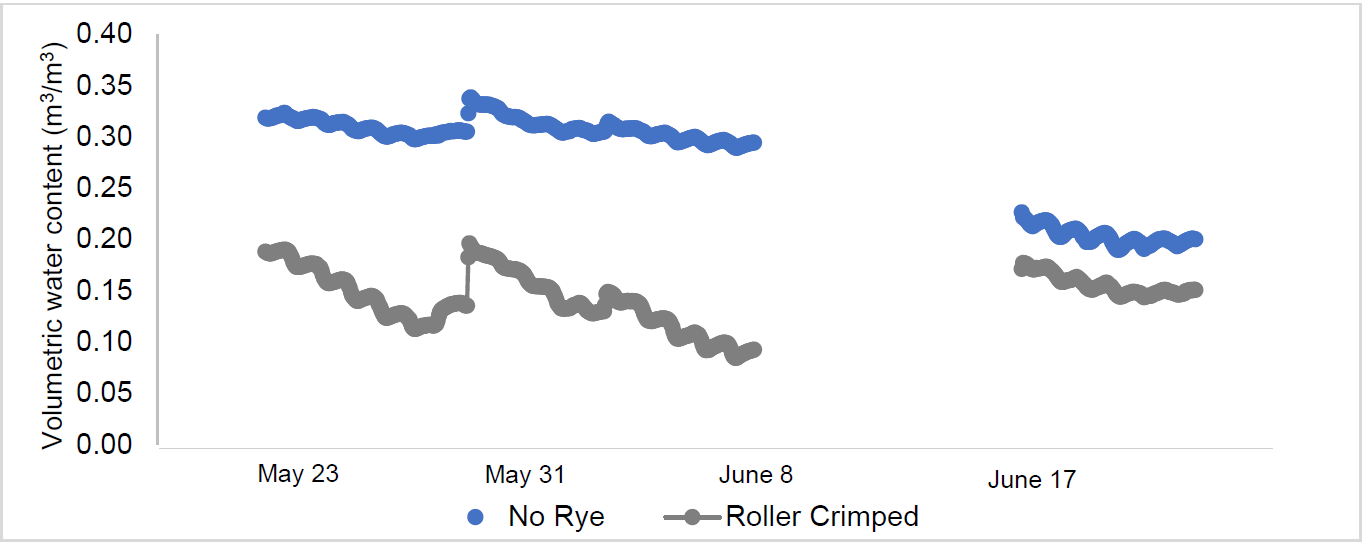
Summer
In 2019 at Elora, soil moisture levels remained higher under the roller crimped treatment after planting (Figure 16). The rye mulch on the soil surface helped to reduce evaporation and maintain higher soil water content following rainfall events. This was important from June 29th through to July 17th, during which time there was no rainfall. As the season progressed and the soybeans canopied, the difference between treatments was reduced.
At the Bornholm site in 2020, once again the opposite trend was observed (Figure 17). The roller crimped treatment had persistently lower soil moisture at 2-inch depth throughout the summer. This was likely due in part to depleted moisture levels from the rye, which was not terminated until June 13. Also, the rye mulch was not very thick, which may have limited its ability to conserve moisture near the soil surface.
Sensors at 12-inch depth showed the reverse: the roller crimped treatment had consistently higher soil moisture than the no rye control. It’s hypothesized that this is because the soybeans in the control treatment grew much more rapidly and developed a deeper root system that was able to access moisture in the subsoil.
Increased access to moisture in the subsoil may be a further explanation as to the slower draw-down of soil moisture at 2 inches in the control treatment. With limited root systems, soybeans in the roller crimped treatment were almost entirely dependent on soil moisture in the upper portion of the soil profile. Soybeans in the no rye control appeared to have access to moisture in both the topsoil and subsoil.
Figure 16. Average soil moisture at the Elora-2019 site. Moisture at 2-inch depth in no-rye control treatment (blue) and roller crimped treatment (grey) from June 21 to August 31.
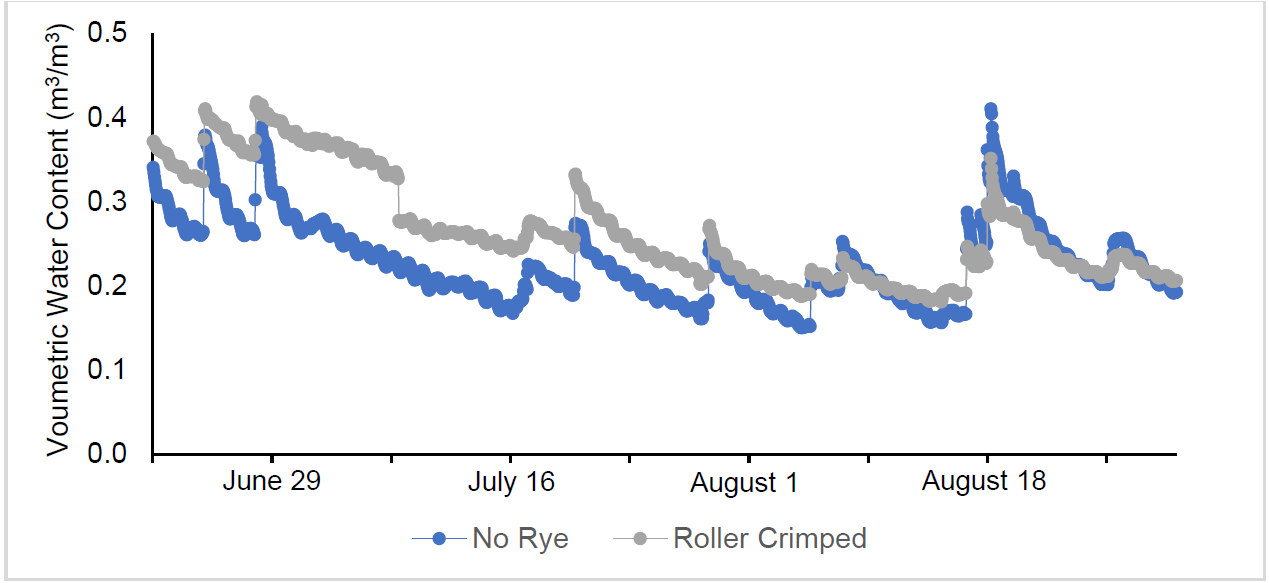
Figure 17. Average soil moisture at the Bornholm site in 2020. Moisture in the no-rye control treatment (dark blue: 2-inch, light blue: 12-inch) and roller crimped treatment (dark grey: 2-inch, light grey: 12-inch) from June 21 to August 31.
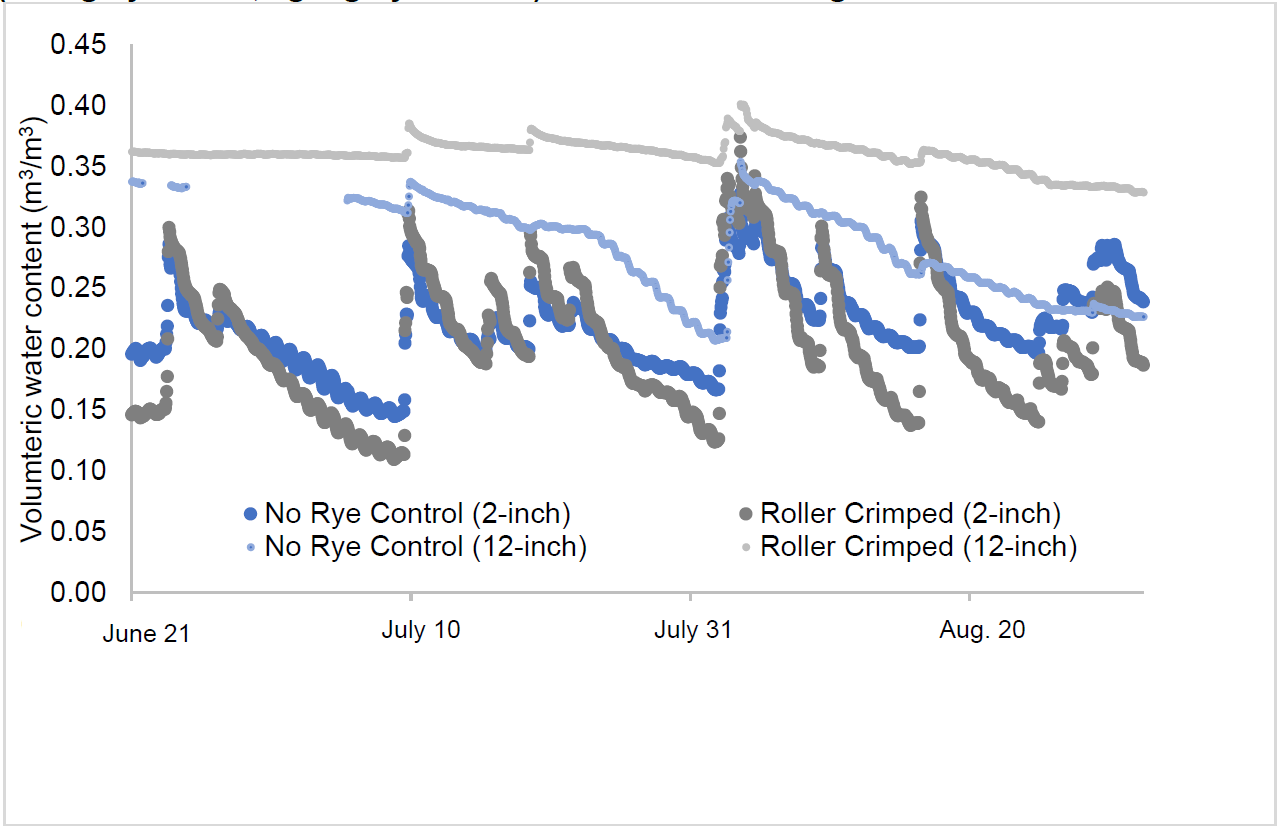
Soil temperature
In the spring, the rye slowed the soil from warming compared to the no-rye control at Elora-2019 – daily maximum temperatures under rye were 5-7⁰C lower in late May and early June. Throughout the summer, the rye mulch had a moderating effect on soil temperature. Soil in the roller crimped treatment had lower daily maximum temperatures and higher daily minimum temperatures than the no-rye control treatment (Figure 18). The soil temperature surpassed 40⁰C five times under the no-rye control but remained below 35⁰C throughout the hottest part of the season in the roller crimped rye treatment.
Figure 18. Average soil temperature (⁰C) at 2-inch depth in no rye (control) treatment (blue) and roller crimped treatment (grey) from June 21 to July 21, 2019
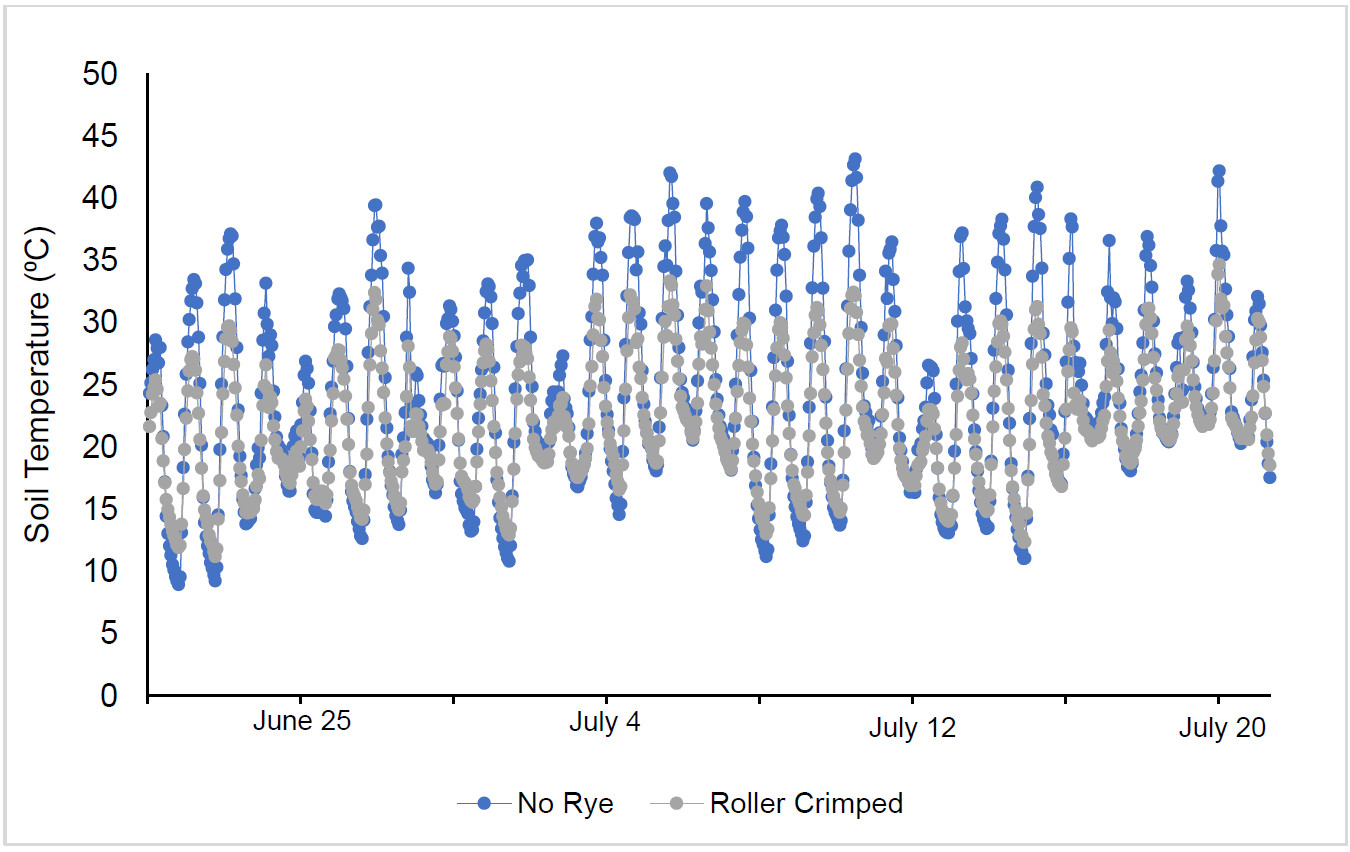
Yield results
Strip trial sites
The average yield across strip trial sites in 2019 and 2020 for soybeans in the roller crimped system was 29.2 bushels/acre, which was 21.7 bu/ac less than the no-rye control yield of 50.9 bu/ac (Table 5). The difference in yield was greater in 2020 (25.8 bu/ac) than in 2019 (11.5 bu/ac), despite several improvements made to the organic no-till system between seasons.
While insufficient mulch and weed pressure, as well as soybean stand damage from crimping, were factors in the low yields at a couple of sites, they did not fully explain the difference. The Drayton and Seaforth sites in 2020, for example, had acceptable weed suppression, but both yielded below 25 bu/ac. It’s believed that dry conditions (~40-100% of normal precipitation in May, June and July for the project area) were exacerbated by the cover crop-based organic no-till system. This, in turn, severely stunted vegetative growth, root development and limited yield potential, as seen in Figure 19.
Soybeans in roller crimped treatments at sites in 2020 had a 30% lower pod count of those in the no rye treatment. Slightly smaller seed size likely further contributed to reduced yields.
Figure 19. Soybeans in a roller crimped strip at the Drayton-2020 site on August 12th. Given a May 24th planting date and narrow spacing, these beans should have canopied well before this date.
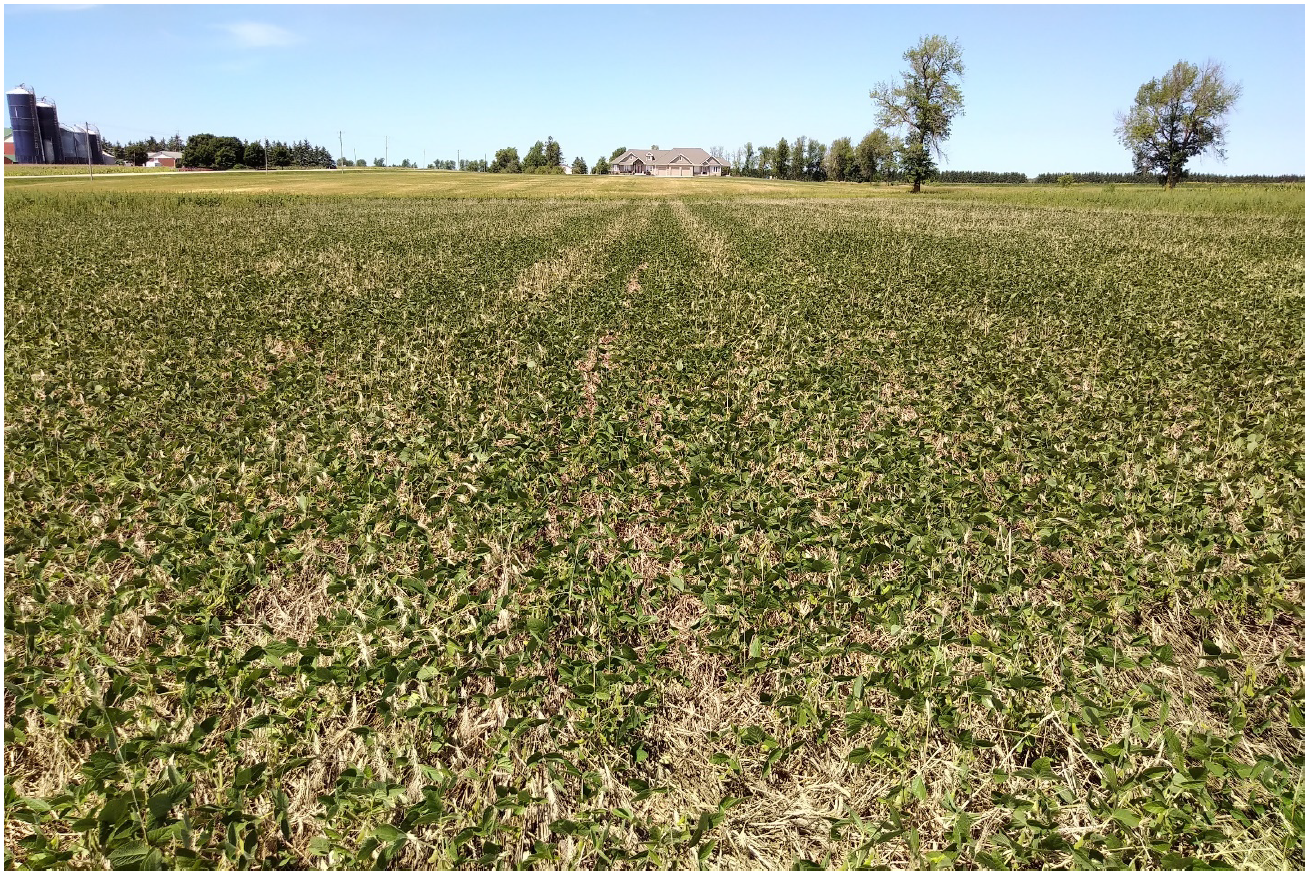
Observational sites
The yield data showed similar trends at observational sites from 2019 to 2020. Cover-based organic no-till yields ranged from unharvestable to 47 bu/acre in 2019 (Table 5). Sharper openers, increased down-pressure and a higher soybean seeding rate may have helped in overcoming some of these barriers at the unharvestable Blyth site. At the St. Marys M site in 2019 and all St. Marys sites in 2020, narrow row spacing at a high soybean seeding rate enabled the grower to achieve reasonable weed suppression despite low rye biomass. As with the strip trial sites, it’s believed that low soil moisture conditions made worse by the rye contributed to the yield reduction in 2020.
Table 5. Summarized yield results from all sites. All values corrected to 13% moisture. Statistically significant differences are shown by different letters.
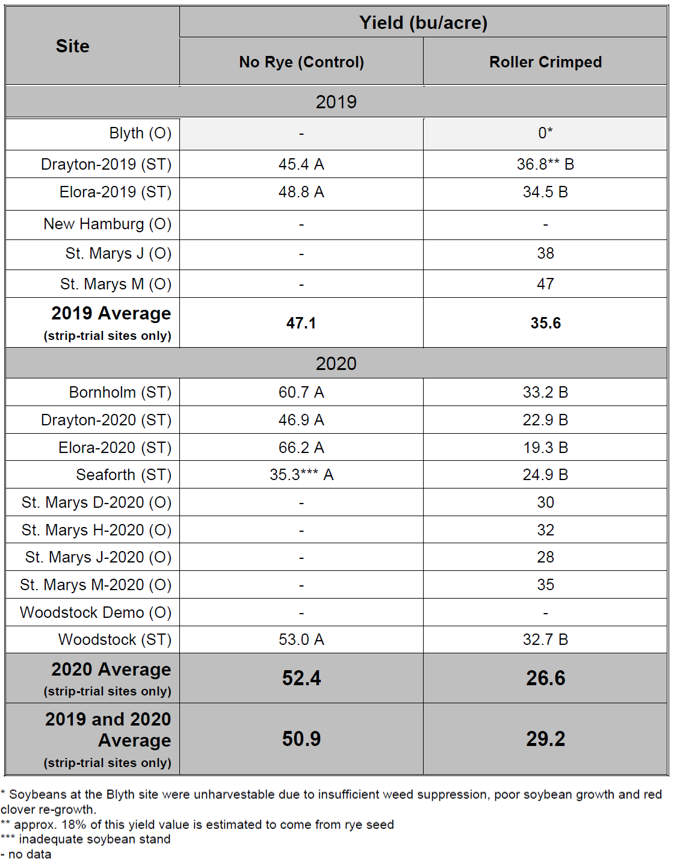
Additional treatments at Bornholm
The site at Bornholm a total of six treatments – an addition of four beyond what is reported in Table 5. The two no-rye control strips yielded the highest – 75.4 and 60.7 bu/ac, respectively, for the May 23 and June 9 seeding dates (Table 6). The comparison also highlighted the importance of timely soybean seeding. The June 9-planted soybeans planted into terminated rye residue yielded 57.5 bu/ac, which was not statistically different from the no-rye treatment.
Soybeans seeded into rye at the boot stage and crimped three weeks later yielded 37.6 bu/ac, which was not statistically different than the soybeans planted on June 9th (33.2 bu/ac). It was a higher yield than the later seeded soybeans planted at a lower population, which yielded only 30.5 bu/ac. Although the early-seeded soybeans into standing rye performed relatively well, it should be noted that the soybeans struggled under the rye canopy due to slug feeding and lack of light.
This is the first known replicated trial evaluating the practice of interseeding into standing rye 3-4 weeks before crimping. More research is required to establish greater confidence in this practice.
Table 6. Soybean yields from five different treatments at the Bornholm site in 2020. All values corrected to 13% moisture. Statistically significant differences are shown by different letters.
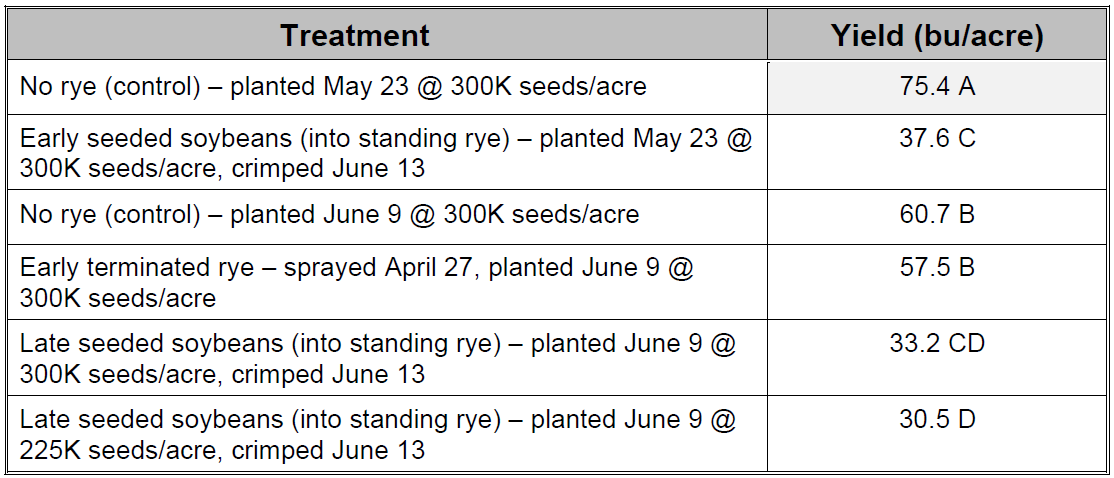
Summary
Cover crop-based organic no-till soybean production was evaluated at sixteen different sites across southwestern Ontario over two years. Based on the yield results to date, the organic no-till system represents too much risk to recommend on a large scale. It is possible to grow a cover crop that can do a good job suppressing weeds, though this was not universally achieved. Early-planting and good base soil fertility to support tillering and aggressive rye growth are key. Also, use of appropriate soybean seeding equipment is critical.
The below-average precipitation in the spring and early summer of 2020 exposed a key vulnerability of the system – resulting in disappointing yields, even in cases where everything else was done properly.
Based on observations from the past two seasons, the following lessons were learned:
- Select fields with low perennial weed pressure and at least moderate background fertility (e.g. >15 ppm P, >100 ppm K)
- Seed rye early – ideally mid-September – and thick to achieve sufficient rye biomass
- Use appropriate seeding equipment to ensure good cutting of the rye mulch, placement of soybeans, and closing of the seed trench
- Seed soybeans at a high rate (minimum of 250,000 up to 300,000+ seeds/acre)
Cover crop-based organic no-till requires a high level of management, as well as adaptive management to adjust to the weather. In the future, it may be possible to identify unsuitable conditions and move to a plan B (e.g. rye harvested as forage). Given the potential benefits of organic no-till soybean production, such as labour and fuel savings, erosion reduction and improved soil health, the system will continue to be evaluated.
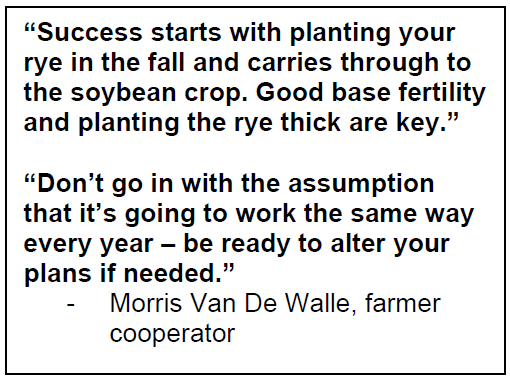
Next Steps
Cereal rye was seeded in the fall of 2020 to evaluate cover crop-based organic no-till for another season at Elora, Bornholm and two on-farm sites. It is important to assess the system for at least three seasons to better understand how it performs across different weather conditions.
Acknowledgements
This project was supported by OSCIA Tier 2 project funding. Donations of cereal rye seed were generously made by Cribit Seeds and The Andersons (formerly Thompsons Ltd.). Ecological Farmers Association of Ontario (EFAO) assisted with statistical analysis and financial support through their Farmer-Led Research Program. Soils at Guelph supported the Woodstock strip-trial site in 2020. Thank you to Horst Bohner and Mike Cowbrough for key project support (OMAFRA). Finally, thank you to the farmer cooperators who made the project possible.
Project Contacts:
For more information, contact Jake Munroe, Soil Management Specialist (Field Crops), OMAFRA at: jake.munroe@ontario.ca or 519 301-0548.
